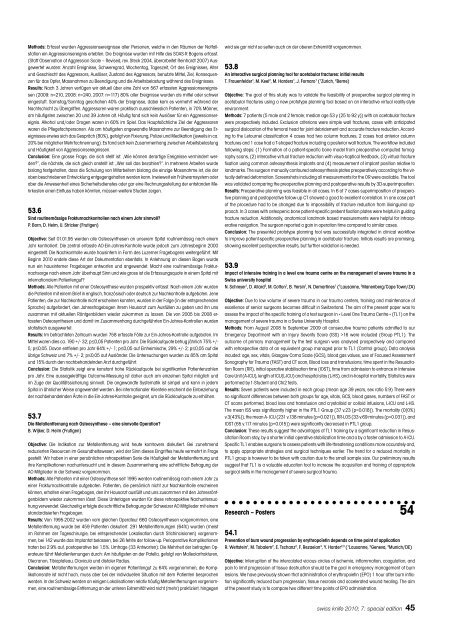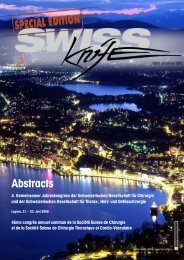Anorectal Manometry in 3D NEW! - Swiss-knife.org
Anorectal Manometry in 3D NEW! - Swiss-knife.org
Anorectal Manometry in 3D NEW! - Swiss-knife.org
You also want an ePaper? Increase the reach of your titles
YUMPU automatically turns print PDFs into web optimized ePapers that Google loves.
Methods: Erfasst wurden Aggressionsereignisse aller Personen, welche <strong>in</strong> den Räumen der Notfallstation<br />
e<strong>in</strong> Aggressionsereignis erlebten. Die Ereignisse wurden mit Hilfe des SOAS-R Bogens erfasst.<br />
(Staff Observation of Aggression Scale – Revised, rev. Steck 2004, überarbeitet Re<strong>in</strong>hardt 2007) Ausgewertet<br />
wurden: Anzahl Ereignisse, Schweregrad, Wochentag, Tageszeit, Ort des Ereignisses, Alter<br />
und Geschlecht des Aggressors, Auslöser, Zustand des Aggressors, benutzte Mittel, Ziel, Konsequenzen<br />
für das Opfer, Massnahmen zu Beendigung und die Arbeitsbelastung während des Ereignisses.<br />
Results: Nach 3 Jahren verfügen wir aktuell über e<strong>in</strong>e Zahl von 567 erfassten Aggressionsereignissen<br />
(2009: n=210, 2008: n=240, 2007: n=117) 80% aller Ereignisse wurden als mittel oder schwer<br />
e<strong>in</strong>gestuft. Samstag/Sonntag geschahen 40% der Ereignisse, dabei kam es vermehrt während der<br />
Nachtschicht zu Übergriffen. Aggressoren waren praktisch ausschliesslich Patienten, <strong>in</strong> 70% Männer,<br />
am häufigsten zwischen 20 und 39 Jahren alt. Häufig fand sich ke<strong>in</strong> Auslöser für e<strong>in</strong> Aggressionsereignis.<br />
Alkohol und/oder Drogen waren <strong>in</strong> 60% im Spiel. Das Hauptsächliche Ziel der Aggressoren<br />
waren die Pflegefachpersonen. Als am häufigsten angewandte Massnahme zur Beendigung des Ereignisses<br />
erwies sich das Gespräch (80%), gefolgt von Fixierung, Polizei und Medikation (jeweils <strong>in</strong> ca.<br />
20% bei möglicher Mehrfachnennung). Es fand sich ke<strong>in</strong> Zusammenhang zwischen Arbeitsbelastung<br />
und Häufigkeit von Aggressionsereignissen.<br />
Conclusion: E<strong>in</strong>e grosse Frage, die sich stellt ist: „Wie können derartige Ereignisse verm<strong>in</strong>dert werden?“,<br />
die nächste, die sich gleich anstellt ist: „Wer soll das bezahlen?“. In mehreren Arbeiten wurde<br />
bislang festgehalten, dass die Schulung von Mitarbeitern bislang die e<strong>in</strong>zige Massnahme ist, die der<br />
oben beschriebenen Entwicklung entgegengehalten werden kann. Inwieweit e<strong>in</strong> Frühwarnsystem oder<br />
aber die Anwesenheit e<strong>in</strong>es Sicherheitsdienstes oder gar e<strong>in</strong>e Rechnungsstellung der entstanden Mehrkosten<br />
e<strong>in</strong>en E<strong>in</strong>fluss haben könnten, müssen weitere Studien zeigen.<br />
53.6<br />
S<strong>in</strong>d rout<strong>in</strong>emässige Frakturnachkontrollen nach e<strong>in</strong>em Jahr s<strong>in</strong>nvoll?<br />
P. Born, D. Heim, U. Stricker (Frutigen)<br />
Objective: Seit 01.01.95 werden alle Osteosynthesen an unserem Spital rout<strong>in</strong>emässig nach e<strong>in</strong>em<br />
Jahr kontrolliert. Die zentral erfasste AO-E<strong>in</strong>-Jahres-Kontrolle wurde jedoch zum Jahresbeg<strong>in</strong>n 2000<br />
e<strong>in</strong>gestellt. Die Nachkontrolle wurde haus<strong>in</strong>tern <strong>in</strong> Form des Luzerner Fragebogens weitergeführt. Mit<br />
Beg<strong>in</strong>n 2010 endete diese Art der Dokumentation ebenfalls. In Anlehnung an diesen Bogen wurde<br />
nun e<strong>in</strong> haus<strong>in</strong>terner Fragebogen entworfen und angewendet. Macht e<strong>in</strong>e rout<strong>in</strong>emässige Frakturnachs<strong>org</strong>e<br />
nach e<strong>in</strong>em Jahr überhaupt S<strong>in</strong>n und wie gross ist die Erfassungsquote <strong>in</strong> e<strong>in</strong>em Spital mit<br />
<strong>in</strong>ternationalem Patientengut?<br />
Methods: Alle Patienten mit e<strong>in</strong>er Osteosynthese wurden prospektiv erfasst. Nach e<strong>in</strong>em Jahr wurden<br />
die Patienten mit e<strong>in</strong>em Brief <strong>in</strong> englisch, französisch oder deutsch zur Nachkontrolle aufgeboten. Jene<br />
Patienten, die zur Nachkontrolle nicht ersche<strong>in</strong>en konnten, wurden <strong>in</strong> der Folge (<strong>in</strong> der entsprechenden<br />
Sprache) aufgefordert, den Jahresfragebogen ihrem Hausarzt zum Ausfüllen zu geben und ihn uns<br />
zusammen mit aktuellen Röntgenbildern wieder zukommen zu lassen. Die von 2005 bis 2008 erfassten<br />
Osteosynthesen und damit im Zusammenhang durchgeführten E<strong>in</strong>-Jahres-Kontrollen wurden<br />
statistisch ausgewertet.<br />
Results: Im betrachteten Zeitraum wurden 758 erfasste Fälle zur E<strong>in</strong>-Jahres-Kontrolle aufgeboten. Im<br />
Mittel waren dies ca. 190 +/- 32; p≤0,05 Patienten pro Jahr. Die Rücklaufquote betrug jährlich 75% +/-<br />
5; p≤0,05. Davon entfielen pro Jahr 64% +/- 1; p≤0,05 auf E<strong>in</strong>heimische, 29% +/- 2; p≤0,05 auf die<br />
übrige Schweiz und 7% +/- 2; p≤0,05 auf Ausländer. Die Untersuchungen wurden zu 85% am Spital<br />
und 15% durch den nachbehandelnden Arzt durchgeführt.<br />
Conclusion: Die Statistik zeigt e<strong>in</strong>e konstant hohe Rücklaufquote bei signifikanten Patientenzahlen<br />
pro Jahr. E<strong>in</strong>e aussagekräftige Outcome-Messung ist daher auch am e<strong>in</strong>zelnen Spital möglich und<br />
im Zuge der Qualitätssicherung s<strong>in</strong>nvoll. Die angewandte Systematik ist simpel und kann <strong>in</strong> jedem<br />
Spital <strong>in</strong> ähnlicher Weise angewendet werden. Bei <strong>in</strong>ternationaler Klientele ersche<strong>in</strong>t die E<strong>in</strong>beziehung<br />
der nachbehandelnden Ärzte <strong>in</strong> die E<strong>in</strong>-Jahres-Kontrolle geeignet, um die Rücklaufquote zu erhöhen.<br />
53.7<br />
Die Metallentfernung nach Osteosynthese – e<strong>in</strong>e s<strong>in</strong>nvolle Operation?<br />
B. Wijker, D. Heim (Frutigen)<br />
Objective: Die Indikation zur Metallentfernung wird heute kontrovers diskutiert. Bei zunehmend<br />
reduzierten Resourcen im Gesundheitswesen, wird der S<strong>in</strong>n dieses E<strong>in</strong>griffes heute vermehrt <strong>in</strong> Frage<br />
gestellt. Wir haben <strong>in</strong> e<strong>in</strong>er persönlichen retrospektiven Serie die Häufigkeit der Metallentfernung und<br />
ihre Komplikationen nachuntersucht und <strong>in</strong> diesem Zusammenhang e<strong>in</strong>e schriftliche Befragung der<br />
AO Mitglieder <strong>in</strong> der Schweiz v<strong>org</strong>enommen.<br />
Methods: Alle Patienten mit e<strong>in</strong>er Osteosynthese seit 1995 werden rout<strong>in</strong>emässig nach e<strong>in</strong>em Jahr zu<br />
e<strong>in</strong>er Frakturnachkontrolle aufgeboten. Patienten, die persönlich nicht zur Nachkontrolle ersche<strong>in</strong>en<br />
können, erhalten e<strong>in</strong>en Fragebogen, den ihr Hausarzt ausfüllt und uns zusammen mit den Jahresröntgenbildern<br />
wieder zukommen lässt. Diese Unterlagen wurden für diese retrospektive Nachuntersuchung<br />
verwendet. Gleichzeitig erfolgte die schriftliche Befragung der Schweizer AO Mitglieder mit e<strong>in</strong>em<br />
standardisierten Fragebogen.<br />
Results: Von 1995-2002 wurden vom gleichen Operateur 660 Osteosynthesen v<strong>org</strong>enommen, e<strong>in</strong>e<br />
Metallentfernung wurde bei 459 Patienten diskutiert. 291 Metallentfernungen (64%) wurden (meist<br />
im Rahmen der Tageschirurgie, bei entsprechender Lokalisation durch Stich<strong>in</strong>cisionen) v<strong>org</strong>enommen,<br />
bei 142 wurde das Implantat belassen, bei 26 fehlte der follow-up. Perioperative Komplikationen<br />
traten bei 2.9% auf, postoperative bei 1.5%. Umfrage (33 Antworten): Die Mehrheit der befragten Operateure<br />
führt Metallenfernungen durch: Am häufigsten an der Patella, gefolgt von Malleolarfrakturen,<br />
Olecranon, Tibiaplateau, Clavicula und distaler Radius.<br />
Conclusion: Metallentfernungen werden im eigenen Patientengut zu 64% v<strong>org</strong>enommen, die Komplikationsrate<br />
ist nicht hoch, muss aber bei der <strong>in</strong>dividuellen Situation mit dem Patienten besprochen<br />
werden. In der Schweiz werden an e<strong>in</strong>igen Lokalisationen relativ häufig Metallentfernungen v<strong>org</strong>enommen,<br />
e<strong>in</strong>e rout<strong>in</strong>emässige Entfernung an der unteren Extremität wird nicht (mehr) praktiziert, h<strong>in</strong>gegen<br />
wird sie gar nicht so selten auch an der oberen Extremität v<strong>org</strong>enommen.<br />
53.8<br />
An <strong>in</strong>teractive surgical plann<strong>in</strong>g tool for acetabular fractures: <strong>in</strong>itial results<br />
T. Frauenfelder 1 , M. Keel 2 , M. Harders 1 , J. Fornaro 1 ( 1 Zurich, 2 Berne)<br />
Objective: The goal of this study was to validate the feasibility of preoperative surgical plann<strong>in</strong>g <strong>in</strong><br />
acetabular fractures us<strong>in</strong>g a new prototype plann<strong>in</strong>g tool based on an <strong>in</strong>teractive virtual reality-style<br />
environment.<br />
Methods: 7 patients (5 male and 2 female; median age 53 y (25 to 92 y)) with an acetabular fracture<br />
were prospectively <strong>in</strong>cluded. Exclusion criterions were simple wall fractures, cases with anticipated<br />
surgical dislocation of the femoral head for jo<strong>in</strong>t debridement and accurate fracture reduction. Accord<strong>in</strong>g<br />
to the Letournel classification 4 cases had two column fractures, 2 cases had anterior column<br />
fractures and 1 case had a T-shaped fracture <strong>in</strong>clud<strong>in</strong>g a posterior wall fracture. The workflow <strong>in</strong>cluded<br />
follow<strong>in</strong>g steps: (1) Formation of a patient-specific bone model from preoperative computed tomography<br />
scans, (2) <strong>in</strong>teractive virtual fracture reduction with visuo-haptical feedback, (3) virtual fracture<br />
fixation us<strong>in</strong>g common osteosynthesis implants and (4) measurement of implant position relative to<br />
landmarks. The surgeon manually contoured osteosynthesis plates preoperatively accord<strong>in</strong>g to the virtually<br />
def<strong>in</strong>ed deformation. Screenshots <strong>in</strong>clud<strong>in</strong>g all measurements for the OR were available. The tool<br />
was validated compar<strong>in</strong>g the preoperative plann<strong>in</strong>g and postoperative results by <strong>3D</strong>-superimposition.<br />
Results: Preoperative plann<strong>in</strong>g was feasible <strong>in</strong> all cases. In 6 of 7 cases superimposition of preoperative<br />
plann<strong>in</strong>g and postoperative follow-up CT showed a good to excellent correlation. In one case part<br />
of the procedure had to be changed due to impossibility of fracture reduction from ilio<strong>in</strong>gu<strong>in</strong>al approach.<br />
In 3 cases with osteopenic bone patient-specific prebent fixation plates were helpful <strong>in</strong> guid<strong>in</strong>g<br />
fracture reduction. Additionally, anatomical landmark based measurements were helpful for <strong>in</strong>traoperative<br />
navigation. The surgeon reported a ga<strong>in</strong> <strong>in</strong> operation time compared to similar cases.<br />
Conclusion: The presented prototype plann<strong>in</strong>g tool was successfully <strong>in</strong>tegrated <strong>in</strong> cl<strong>in</strong>ical workflow<br />
to improve patient-specific preoperative plann<strong>in</strong>g <strong>in</strong> acetabular fracture. Initials results are promis<strong>in</strong>g,<br />
show<strong>in</strong>g excellent postoperative results, but further validation is needed.<br />
53.9<br />
Impact of <strong>in</strong>tensive tra<strong>in</strong><strong>in</strong>g <strong>in</strong> a level one trauma centre on the management of severe trauma <strong>in</strong> a<br />
<strong>Swiss</strong> university hospital<br />
N. Schreyer 1 , D. Allard 2 , M. Cotton 1 , B. Yers<strong>in</strong> 1 , N. Demart<strong>in</strong>es 1 ( 1 Lausanne, 2 Manenberg/Cape Town/ZA)<br />
Objective: Due to low volume of severe trauma <strong>in</strong> our trauma centers, tra<strong>in</strong><strong>in</strong>g and ma<strong>in</strong>tenance of<br />
excellence of senior surgeons becomes difficult <strong>in</strong> Switzerland. The aim of the present paper was to<br />
assess the impact of the specific tra<strong>in</strong><strong>in</strong>g of a test surgeon <strong>in</strong> « Level One Trauma Centre » (TL1) on the<br />
management of severe trauma <strong>in</strong> a <strong>Swiss</strong> University Hospital.<br />
Methods: From August 2008 to September 2009 all consecutive trauma patients admitted to our<br />
Emergency Department with an Injury Severity Score (ISS) >16 were <strong>in</strong>cluded (Group PTL1). The<br />
outcome of primary management by the test surgeon was analysed prospectively and compared<br />
with retrospective data of an equivalent group managed prior to TL1 (Control group), Data analysis<br />
<strong>in</strong>cuded: age, sex, vitals, Glasgow Coma Scale (GCS), blood gas values, use of Focused Assessment<br />
Sonography for Trauma (FAST) and CT scan, Blood loss and transfusions, time spent <strong>in</strong> the Resuscitation<br />
Room (RR), <strong>in</strong>itial operative stabilisation time (IOST), time from admission to entrance <strong>in</strong> Intensive<br />
Care Unit (A-ICU), length of ICU(L-ICU) and hospital stay (L-HS), and <strong>in</strong>-hospital mortality. Statistics were<br />
performed by t -Student and Chi2 tests.<br />
Results: Seven patients were <strong>in</strong>cluded <strong>in</strong> each group (mean age 39 years, sex ratio 5:9) There were<br />
no significant differences between both groups for age, vitals, GCS, blood gases, numbers of FAST or<br />
CT scans performed, blood loss and transfusion and crystalloid or colloid <strong>in</strong>fusions, L-ICU and L-HS.<br />
The mean ISS was significantly higher <strong>in</strong> the PTL1 Group (37 v.23 [p=0.018]). The mortality (0[0%]<br />
v.3[43%]), the mean A- ICU (231 v.138 m<strong>in</strong>utes [p=0.021]), RR-LOS (33 v.69 m<strong>in</strong>utes [p=0.031]), and<br />
IOST (65 v.117 m<strong>in</strong>utes [p=0.015]) were significantly decreased <strong>in</strong> PTL1 group.<br />
Conclusion: These results suggest the advantages of TL1 tra<strong>in</strong><strong>in</strong>g by a significant reduction <strong>in</strong> Resuscitation<br />
Room stay, by a shorter <strong>in</strong>itial operative stabilization time and a by a faster admission to A-ICU.<br />
Specific TL1 enables surgeons to assess patients with life-threaten<strong>in</strong>g conditions more accurately and,<br />
to apply appropriate strategies and surgical techniques earlier. The trend for a reduced mortality <strong>in</strong><br />
PTL1 group is however to be taken with caution due to the small sample size. Our prelim<strong>in</strong>ary results<br />
suggest that TL1 is a valuable education tool to <strong>in</strong>crease the acquisition and tra<strong>in</strong><strong>in</strong>g of appropriate<br />
surgical skills <strong>in</strong> the management of severe surgical trauma.<br />
Research – Posters 54<br />
54.1<br />
Prevention of burn wound progression by erythropoïet<strong>in</strong> depends on time po<strong>in</strong>t of application<br />
R. Wettste<strong>in</strong> 1 , M. Tobalem 2 , E. Tschanz 2 , F. Rezaeian 3 , Y. Harder 2,3 ( 1 Lausanne, 2 Geneva, 3 Munich/DE)<br />
Objective: Interruption of the <strong>in</strong>tercalated vicious circles of ischemia, <strong>in</strong>flammation, coagulation, and<br />
pa<strong>in</strong> to limit progression of tissue destruction should be the goal <strong>in</strong> emergency management of burn<br />
lesions. We have previously shown that adm<strong>in</strong>istration of erythropoiet<strong>in</strong> (EPO) 1 hour after burn <strong>in</strong>fliction<br />
significantly reduced burn progression, tissue necrosis and accelerated wound heal<strong>in</strong>g. The aim<br />
of the present study is to compare two different time po<strong>in</strong>ts of EPO adm<strong>in</strong>istration.<br />
swiss <strong>knife</strong> 2010; 7: special edition 45
















